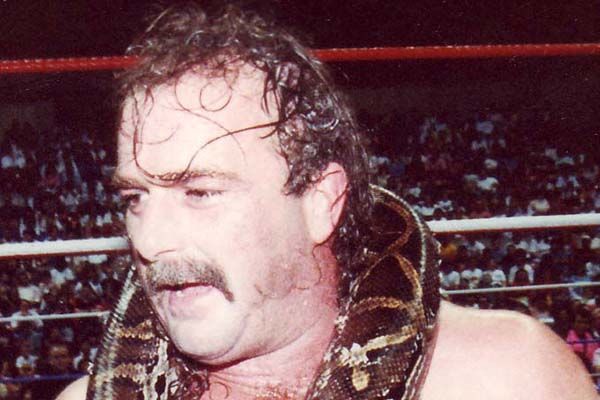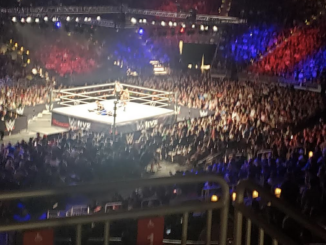
SPOTLIGHTED PODCAST ALERT (YOUR ARTICLE BEGINS A FEW INCHES DOWN)...
WrestleMania 34 is coming up, and being a wrestling fan, I tend to get a little more nostalgic for them olden days of when wrestlers didn’t have scripts with WWE verbage in front of them. DeLorean back to my early days of fandom during the 1990s and you had a product that was hotter than any Seth Rollins theme song (you know, ”Burn It Down?” Okay, I’ll see that bad joke right out the door).
So from now up until “The Grandest Stage of Them All” (with a little help from Wikipedia to fill in the blanks), I will release my Top 50 wrestlers of the 1990s, factoring in their impact from the kid-friendly first half to the cuss-ridden, beer drinking second half to determine where exactly your favorite heel or face fall in rank.
Here’s who we got so far:
#50. Ken Shamrock
#49. Dean Malenko
#48. Jeff Jarrett
#47. Big Bossman
#46. The Sandman
#45. Davey Boy Smith
#44. The Giant
#43. Taz
#42. Ron Simmons
#41. Rob Van Dam
#40. Eddie Guerrero
#39. Chris Benoit
#38. Sabu
#37. Rey Mysterio, Jr.
#36. Sid Vicious
#35. Kane
#34. Sean Waltman
#33. Chris Jericho
#32. Goldust
#31. Raven
#30. The New Age Outlaws
#29. Brian Pillman
#28. The Steiner Brothers
#27. Bam Bam Bigelow
#26. Lex Luger
Rambling into the early 20s reminds one of their college years, so it’s pretty ironic that these next five were seasoned vets of the squared circle by the time the 90s rolled around.
#25: Terry Funk
Hailing From: Amarillo, Tex.
Finisher: Piledriver
By any normal parameters, Terry Funk should have been done with in-ring action in the 90s Now he did retire (many times), but even in the decades to follow it was hard to put the Funker down for the career three-count. While the majority of his stardom came from his time in the 1970s & 80s, the legend that was Terry Funk helped to define the business of the 1990s in many ways.
At the start of 1990, Funk was coming off of a classic feud with Ric Flair from the previous November’s Clash of Champions in an “I Quit” match. He briefly did an interview segment with the promotion until leaving the company.
From there, Funk was all over the wrestling map. He wrestled for Jerry Lawler’s USWA promotion and had a return to Japan for an extremely brutal (get ready for a mouthful) “No Ropes Barbed Wire Exploding Barbed Wire Boards & Exploding Ring Time Bomb Death Match” with good buddy Cactus Jack. However, it was in 1993 where Terry began his most impactful run in the 90s with ECW.
Terry joined when it was still called Eastern Championship Wrestling, but him and his brother Dory certainly brought that “extreme” mindset with them to the Philadelphia promotion. While there, Terry squared off with a “who’s who” of ECW originals. From Shane Douglas, to Sabu, to Tommy Dreamer, Funk helped establish the young stars of the company and in turn, helped the company establish a credible outlaw brand and identity. It could easily be said that without Terry Funk, there could be no ECW and perhaps, no tilt in attitude towards the business’s edgier culture.
After this run was when Funk “retired.” The proverbial “hanging up of the boots” wasn’t for long as he came back to the WWF to tag with Cactus Jack under the persona of Chainsaw Charlie, which was obviously just a chainsaw wielding Funk in overalls and pantyhose over his head. The two feuded with each other as well, but they eventually captured the tag belts from the super hot act of the New Age Outlaws at WrestleMania XIV. In a time of expedient title runs, the duo lost the belts the next night on Raw, but this change in character was an absurdly fun change of pace for an already legendary act.
Funk capped off the 90s with a brief return to ECW (and another “retirement), but closed it off with a last stand in WCW before the company went down in flames.
Out of anybody, Terry Funk was a reinnanssance man in a business that was going through a reinnanssance. He changed with the times and many stars, not just himself, benefited from his impact.
#24: Ted DiBiase
Hailing From: Omaha, Neb.
Finisher: The Million Dollar Dream
Unless you’re a sociopath, nobody likes a millionaire waving his money around and kicking basketballs from kids. Vince McMahon really liked it, however.
Who’s a better counter-balance to that vitamin-eating and prayer-saying Hulk Hogan than “The Million Dollar Man” Ted DiBiase? The act found major success in the late 80s as Vince had DiBiase “live the gimmick” outside of the squared circle too. All that considered (along with DiBiase’s natural charisma and talent) the act transitioned smoothly into the the early part of the decade. He feuded with the Ultimate Warrior and Jake Roberts in 1990, then had a longstanding grudge with his former valet, Virgil. At Survivor Series 1991 he was an intrical part of the debut of The Undertaker.
Then through the years of 1992-93 DiBiase, along with his accountant, I.R.S, Ted formed a tag team called Money Inc.and they would become a major force in WWF’s tag division going up against The Road Warriors, The Steiners and even Hogan & Brutus Beefcake during WrestleMania IX. Money Inc. would win the belt three times and it wasn’t long after that until DiBiase retired from in-ring competition.
“The Million Dollar Man” would still carry on as a manager, however as he formed a stable called “The Million Dollar Corporation” that included the likes of Bam Bam Bigelow, King Kong Bundy, I.R.S., Sid Vicious and eventually Steve Austin (going by his most notable moniker as “The Ringmaster”) .
It may have been during a rebuilding period for WWF, but the Million Dollar Corporation was a primary focus on WWF television. Having a heelish character like DiBiase around provided a mouthpiece for some of the talent who weren’t as good on the mic.
DiBiase left for WCW in 1996 and became the fourth member of the N.W.O. with Hogan, Scott Hall & Kevin Nash. His time in the faction wasn’t immensely long and he soon turned face to manage the Steiner Brothers until he eventually transitioned to a backstage role.
A chunk of DiBiase’s 90s s
uccess was in great deal to his work in the 80s, but it really shows how much longevity the character still had.
#23: Rick Rude
Hailing From: St. Peter, Minn.
Finisher: Rude Awakening
Rick Rude’s 90s in-ring tenure didn’t last very long – only four years as a matter of fact. He started the decade out in the WWF having a feud with Jimmy Snuka and reignited another round with the Ultimate Warrior who he had a major-league feud with in ‘89. Rude was one of the best at working in the ring so it makes absolute sense that he would be paired up with someone as bad at wrestling as the Warrior was.
By the end of 1990 however, Rude was done in the WWF and found himself down south for WCW by the end of 1991.
He aligned himself with Paul E. Dangerously’s “Dangerous Alliance” where he took the leadership reigns of the faction that consisted of Arn Anderson, Larry Zybsko and Steve Austin. It didn’t take him long to win the U.S. Title from Sting and to become a prominent role in the company as a top heel act, holding the belt for a 14-month reign. He was voted “The most hated wrestler of 1992” by PWI, and for someone who was renowned as a great heel, that had to feel good.
Rude then went on to hold the WCW International World Heavyweight Championship on three separate occasions in feuds with Sting and Ric Flair. His final title win against Sting is where he injured his back and after that, Rude’s wrestling career was done.
Rude didn’t show back up in the business until 1997 where he became a commentator for ECW and even had a match in a six-man tag to really mark the last of his work in-ring.
This led to him being a manager for DX in the late summer of 1997 and stayed with them until the Montreal Screwjob went down He (along with that guy Bret Hart) soon showed up in WCW. Not coincidentally since Raw was taped at the time, this made Rick Rude the first (and only) person to be on an episode of Raw & Nitro on the same night. He also became the first wrestler to be apart of both DX and the N.W.O. and stayed with the faction (black, white or red) until he was finished with WCW in the first quarter of 1999.
#22: Jake “The Snake” Roberts
Hailing From: Stone Mountain, Ga.
Finisher: The DDT
Like Roddy Piper in the 80s, Jake Roberts gave the early 90s WWF a bit of an injected darker side that added to the product. He’d cut deep promos that would make you think more than just the reds & yellow watercolors of the kid-friendly Hulkamania or the jibberish ramblings of the face-painted “spirit of the Warriors.” Jake “The Snake”’s persona was every bit as slithery as his namesake and older fans of the product appreciated it.
At the start of the decade he’d feud with Ted DiBiase, and eventually face off with Randy Savage in what was a super famous feud involving Savage getting bit by a devenomized cobra (real fun stuff for the kids).
Jake’s first WWF run came to an end in a WrestleMania VIII match with The Undertaker, whom he before had previous alliances with. Later that year, he signed with WCW for what ended up being a very short stint with the company, but did feud with Sting during that time.
It wasn’t until 1996 when Jake found his way back into the WWF where he infamously lost to Steve Austin in the King of The Ring finals and Austin 3:16 was born. He stayed with the company until being fired in early 1997 and then had a few goes with ECW.
Jake’s substance abuse problems were at a critical peak during this decade so as dark as his times were outside of the wrestling ring, he still had enough success to get him at #22 on the list.
#21: Big Van Vader
Hailing From: Boulder, Col
Finisher: The Vader Bomb
Vader’s 1990s was almost evenly divided by three separate runs in Japan. He started it in New Japan as a main eventer, then returned in 1996 for a one-off with legend Antonio Inoki and closed the decade down with time in All-Japan.
Vader was figuratively and literally huge in Japan so it was only a matter of time until the bolder from Boulder made his way to the States. WCW roped them into their web of disarray as a full-time worker in 1992 and became a prominent monster heel for the likes of Sting, Nikita Koloff, Ric Flair and Cactus Jack. Vader would become the WCW Heavyweight Champion three times during his stay and would also win the U.S. Title.
1995 would find him feuding with Hogan in the World Title picture again in the role as an unstoppable monster, which obviously, Hogan ended up winning. Vader would then get fired and off to Japan he went for that aforementioned Inoki one-off.
Vader was built up big-time for his WWF run and destroyed everyone in sight including “WWF President” Gorilla Monsoon when he showed up on the scene. He started a feud with Yokozuna and eventually found his way into the WWF Championship picture with Shawn Michaels. Both being extremely difficult in their own right to work with, the two were far from a match made in heaven and the feud ended with Shawn winning at Summer Slam.
The hands of “Vader Time” would tick towards The Undertaker and then eventually him being on the American side of the feud with team Canada’s Hart Foundation. This is where Vader became a babyface and he stayed that way until he fizzled out of the company in late 1998.
His WWF run wasn’t as significant as his times in WCW or Japan, but Vader’s tenure in the latter proved just how big of a star he was in the 90s.
What do you think of the list so far? Are my choices “simply Ravishing” or do I need a “Rude Awakening”?
Follow me @DominicDeAngelo and let me have it.
NOW CHECK OUT LAST WEEK’S COLUMN: The Top 50 Wrestlers Of The 1990s (pt. 5) – #30-26: New Age Outlaws, Pillman, Steiners, Luger, Bigelow




We started watching wrestling when we got cable in 1996. I’ve really enjoyed reading your Top 50 articles and reminiscing about the ‘old days’. Thanks!